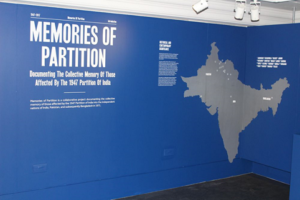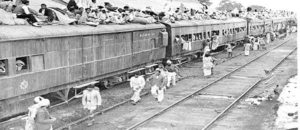Memories of Division.
Relevance:
- GS Paper 1
- Post-independence consolidation
- The Freedom Struggle.
Why in News?
Prime Minister Modi’s call for Partition Horrors Remembrance Day to foster unity and social harmony.
Two-Nation Theory and Jinnah’s Mobilization:
- Sir Syed Ahmad khan was the first exponent of the Two-Nation Theory in the modern era.
- Muhammad Ali Jinnah formulated the concept that religion plays a pivotal role in shaping the national identity of Indian Muslims and Hindus. He labeled this notion as the catalyst behind the Muslim awakening for the establishment of Pakistan.
- Jinnah’s ability to mobilize temporary Muslim support led to the partition of India.
Fallacy of Partition and Creation of Pakistan:
- Partition of India was arbitrary and reckless, with only a little over half of Muslims migrating to Pakistan.
- The Two-Nation Theory’s fallacy became evident as Bangladesh emerged in 1971, challenging the idea of a separate homeland.
Gandhi’s Unity and Jinnah’s Transformation:
- Gandhi aimed for Hindu-Muslim unity and entered politics advocating for harmony.
- Jinnah, once seen as a unifying figure, shifted towards separatism, becoming the “wrecker of Indian unity.”
Nehru’s Stance and Costs of Partition:
- Nehru’s transformation from dismissing partition to accepting it marked a pragmatic shift.
- Leaders began viewing partition as an inevitable cost of achieving independence.
Events That Led To The Partition Of India:
| Year | Event | Description |
| 1905 | Partition of Bengal | The British partitioned Bengal, dividing the province into two parts: one with a Hindu majority and the other with a Muslim majority. This was done in an attempt to disrupt Hindu-Muslim unity. |
| 1909 | Morley-Minto Reforms | The British introduced separate electorates for Muslims, giving them the right to vote for their own representatives in the Indian Legislative Council. This further emphasized the separate political interests of Muslims and Hindus. |
| 1919 | Montagu-Chelmsford Reforms | The British introduced reserved seats for Muslims in the provincial and central legislatures, further highlighting communal differences. The Non-Cooperation Movement was also initiated around this time, which united Hindus and Muslims around the Khilafat issue. However, it was later called off due to the Chauri Chaura incident. |
| 1930 | Muhammad Iqbal’s Demand for a Separate Muslim State | Muhammad Iqbal, a Muslim poet and philosopher, led the Muslim League and demanded a separate Muslim state. He emphasized the distinct nations and incompatibility between Muslims and Hindus. The Congress Party still advocated a united India. |
| 1932 | Communal Award | The British strengthened separate electorates through the Communal Award, following their policy of divide and rule. |
| 1940 | Jinnah’s Two-Nation Theory | Muhammad Ali Jinnah, the leader of the Muslim League, declared at the Lahore Resolution that Hindus and Muslims were two distinct nations and couldn’t coexist within a single state. |
| 1942 | Cripps Mission | The Cripps Mission proposed India’s Dominion status under the British Empire, but this was interpreted differently by the Congress Party and the Muslim League. |
| 1946 | Direct Action Day | Jinnah declared Direct Action Day, demanding an independent Pakistan. This led to communal tensions in various regions of India. |
| 1947 | Partition of India | The British agreed to the partition of India, creating two separate dominions: India and Pakistan. This was a traumatic event that led to widespread violence and displacement. |
Analysis of Factors Leading to the Two-Nation Theory and Partition:
Colonial State’s Policies:
- Promotion of Communal Divisions: The introduction of separate electorates and the recognition of communal leaders as exclusive representatives reinforced the notion of distinct religious identities and interests.
- Communalism through Divide and Rule: Employing a divisive strategy, the colonial state exacerbated communal tensions, nurturing an atmosphere of extreme communalism that paved the way for the demand for separate nations.
- Entrenchment of Separation: By endorsing communal representation, the colonial state inadvertently laid the foundation for the belief that religious communities needed separate political entities, fueling the idea of distinct nations.
Congress’s Dilemmas and Decisions:
- Initial Unity Aim: The Congress initially espoused the vision of a united India and resisted the idea of a separate nation based on religion, aiming to foster interfaith harmony.
- Shift in Stance: Internal divisions within the Congress and unsuccessful negotiations with the Muslim League led to a transformation in its position, as it reluctantly started acknowledging the concept of Pakistan.
- Temporary Acceptance of Partition: Faced with escalating communal violence and a perception of popular sentiment, the Congress reluctantly consented to the demand for Pakistan as a temporary measure to curb turmoil.
- Hope for Reunification: The Congress believed that over time, the impracticality of partition would become evident, and efforts towards reconciliation and reunification could prevail.
- Failed Negotiations: The inability to establish a unified front with the Muslim League and the breakdown of negotiations contributed to the Congress’s eventual acceptance of the partition as an inevitable outcome.
Consequences of the Partition:
Society:
- Mass Migration: The partition sparked the largest human migration in history, as millions of Hindus, Sikhs, and Muslims crossed borders in search of safety and belonging.
- Violence and Atrocities: This migration was marred by violence and atrocities, with communities committing acts of brutality against each other, leaving scars on the collective memory.
- Trauma and Insecurity: The upheaval bred a sense of trauma and insecurity that continues to affect social dynamics in India, shaping relationships between communities.
Politics:
- Creation of Nations: The partition gave rise to India and Pakistan as separate nations, resulting in the displacement of millions and setting the stage for a complex political relationship.
- Ongoing Conflict: India and Pakistan have experienced persistent conflict, marked by three major wars and numerous smaller clashes, exacerbating regional instability.
- Nuclear Arms Race: The partition also contributed to a nuclear arms race between the two nations, intensifying tensions and posing global security concerns.
International Relations:
- Emergence of Pakistan: Pakistan’s emergence as a new Muslim state aligned with Western powers during the Cold War, influencing global geopolitical dynamics.
- India’s Non-Alignment: India, on the other hand, pursued a policy of non-alignment, forging diplomatic ties with both the United States and the Soviet Union.
- Decolonization Implications: The partition served as an early example of colonial powers dividing territory along religious lines, influencing decolonization processes worldwide.
Lessons Learned from Partition:
- Humanitarian Cost: The partition highlighted the immense human suffering caused by communal violence, emphasizing the need to prevent such tragedies in the pursuit of national aspirations.
- Unity Over Divisiveness: The division demonstrated the detrimental impact of communal and divisive ideologies, underscoring the importance of fostering unity and respect among diverse communities.
- Diplomacy and Dialogue: The partition’s aftermath showed the necessity of open communication, negotiation, and diplomatic efforts to resolve conflicts and prevent the escalation of tensions.
- Interfaith Harmony: The partition’s scars emphasize the significance of promoting interfaith harmony and understanding, celebrating cultural diversity while discouraging religious polarization.
- Long-Term Reconciliation: The partition’s legacy urges long-term efforts towards reconciliation, acknowledging historical wounds, and working towards building bridges of understanding and cooperation.
- Global Implications: The partition’s impact on international relations highlights the importance of addressing ethno-religious conflicts on a global scale to prevent similar divisions elsewhere.
The partition of India in 1947 has left an enduring impact, seen in the scars of communal strife, on going regional conflicts, and geopolitical shifts. As India and Pakistan navigate their complex relationship, the lessons from partition emphasize the importance of fostering cooperation, understanding, and reconciliation for a more harmonious future.
Sources:
https://epaper.indianexpress.com/3747374/Delhi/August-12-2023#page/15/2
https://thewire.in/culture/manchester-museums-partition-exhibit
Mains Question:
Q “Examine the multifaceted impact of the partition of India in 1947, focusing on its repercussions on society, politics, and international relations, and discuss the lessons it offers for promoting unity, diplomacy, and interfaith understanding in today’s world.”250 words.





